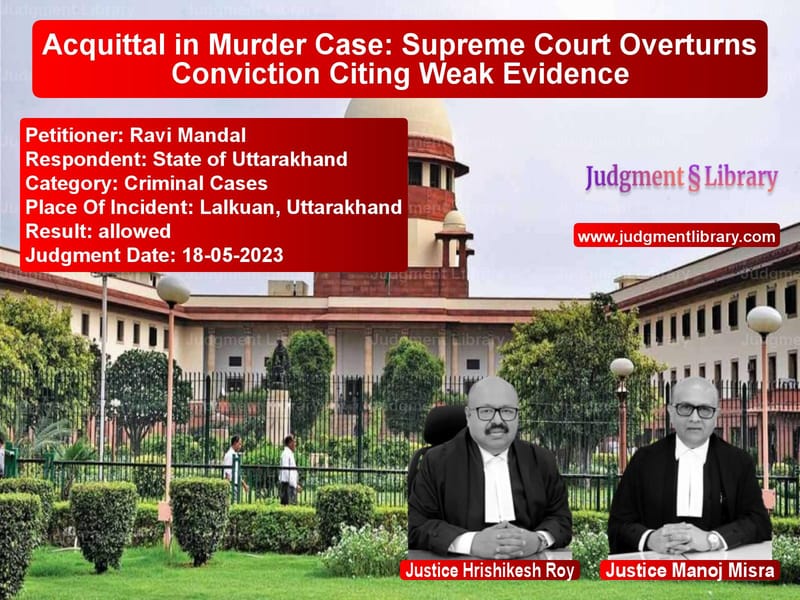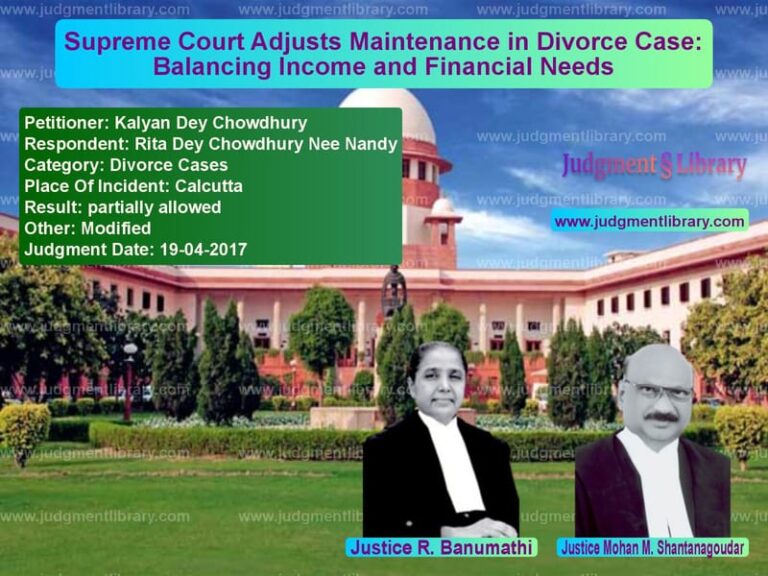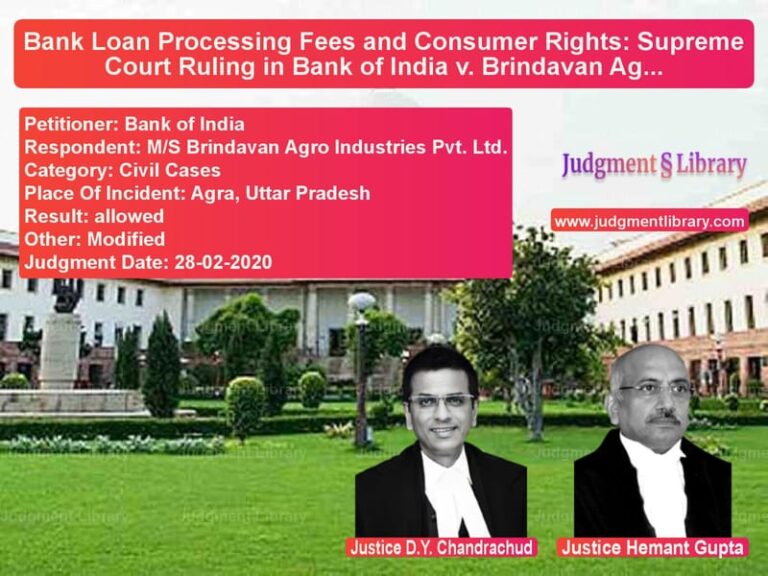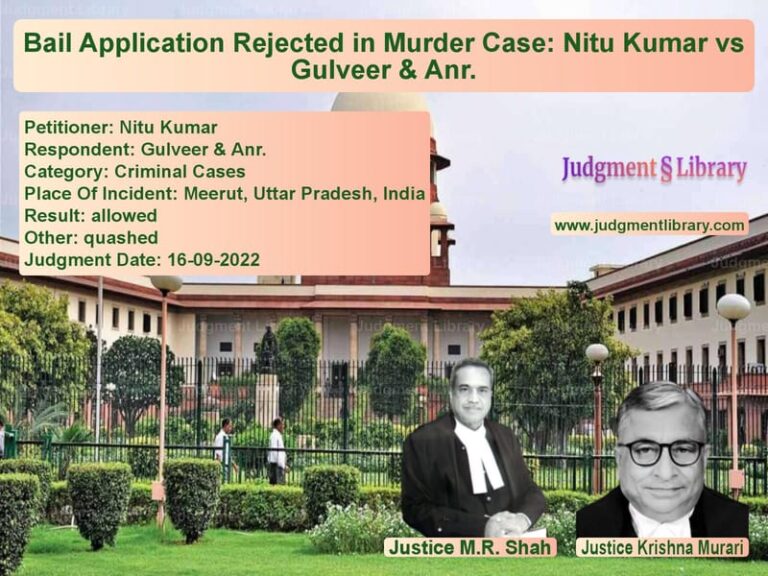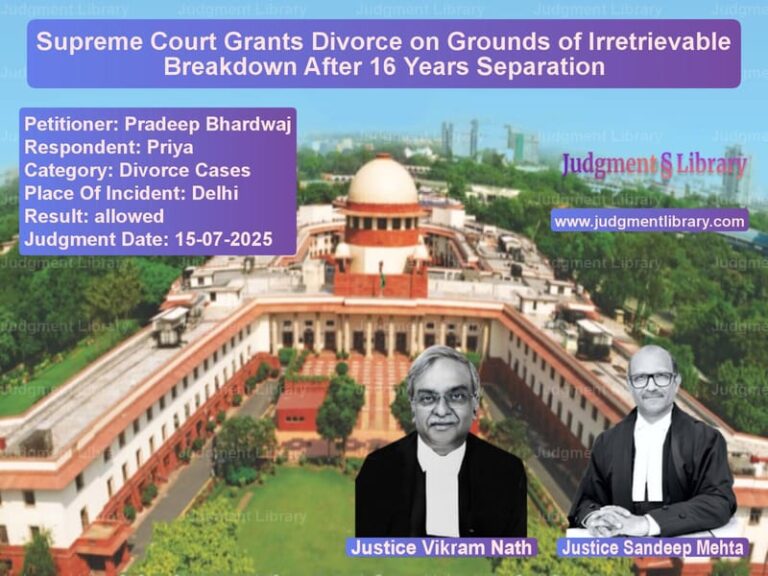Acquittal in Murder Case: Supreme Court Overturns Conviction Citing Weak Evidence
The Supreme Court of India, in the case of Ravi Mandal vs. State of Uttarakhand, overturned the conviction of two accused, Ravi Mandal and Shabbir, who had been sentenced to life imprisonment for the murder of Chhotu @ Surjeet. The Court ruled that the evidence presented was insufficient, unreliable, and based on suspicion rather than conclusive proof, leading to the acquittal of the accused.
Background of the Case
The case originated on November 1, 2001, when Man Singh (PW-1), the father of the deceased, discovered his son’s dead body in a forest near Government Inter College, Lalkuan, Uttarakhand. He immediately lodged an FIR at Lalkuan Police Station, naming his son’s friends, Govind and Ravi Bangali (later identified as Ravi Mandal), as suspects. However, on November 10, 2001, he submitted another written statement revising his claim, stating that it was not Govind but Shabbir, along with Ravi and Mazhar Khan, who had been with the deceased on the night of the murder.
Legal Issues Considered
The Supreme Court examined several key issues, including:
- Whether the prosecution had established the accused’s guilt beyond reasonable doubt.
- Whether the ‘last seen together’ evidence was credible and sufficient for conviction.
- Whether the recovery of weapons was legally tenable and reliable.
- Whether the forensic evidence linking the accused to the crime was admissible.
- Whether procedural lapses, such as the failure to record crucial witness statements properly, weakened the prosecution’s case.
Arguments Before the Supreme Court
Petitioner’s (Accused’s) Arguments
The appellants argued that:
- The prosecution’s case was based purely on circumstantial evidence, with no direct witness testimony.
- The prosecution relied on ‘last seen together’ evidence provided by PW-2 and PW-5, both of whom were unreliable and had provided their statements months after the incident.
- The absence of independent public witnesses for the alleged recovery of weapons weakened the credibility of the prosecution’s claims.
- The ballistic report, which allegedly linked the recovered pistol to the crime, was never put to the accused during their Section 313 CrPC examination.
- The police had manipulated witness statements and fabricated evidence to falsely implicate the accused.
Respondent’s (Prosecution’s) Arguments
The prosecution countered that:
- The deceased was last seen alive with the accused, as testified by PW-2 (Chandan Singh) and PW-5 (Mahendra Khurana).
- The forensic evidence confirmed that the empty cartridge found at the crime scene matched the country-made pistol recovered from Shabbir.
- There was no reason for PW-2 and PW-5 to falsely implicate the accused.
- The accused had a motive for committing the crime, as the deceased had financial disputes with them.
- The chain of circumstantial evidence was sufficient to establish guilt beyond a reasonable doubt.
Supreme Court’s Observations
Reliability of ‘Last Seen Together’ Evidence
The Court scrutinized the testimony of PW-2 and PW-5, concluding that their delayed statements significantly weakened their credibility. The Court noted that PW-2 gave his statement only on February 18, 2002, nearly three and a half months after the incident, without providing a convincing reason for the delay. PW-5’s testimony was similarly unreliable, as he initially included Govind in the list of people last seen with the deceased but later omitted his name.
Flaws in the Recovery of Weapons
The Court found serious procedural lapses in the alleged recovery of weapons. It noted that:
- No independent public witness had testified about the recovery.
- The investigating officer (PW-10) prepared the site plan of the alleged recovery location 12 days after the arrest, raising doubts about its authenticity.
- The prosecution failed to explain why forensic examination of the weapon was delayed until January 15, 2002, when it was allegedly recovered on November 24, 2001.
- The forensic report, which supposedly confirmed that the bullet found at the scene matched Shabbir’s weapon, was never put to the accused in their examination under Section 313 CrPC, violating their right to a fair trial.
Procedural Lapses and Fabrication of Evidence
The Court criticized the investigation for its inconsistencies and manipulation of witness statements. It found that:
- The FIR initially named Govind, but later, Shabbir’s name was added, raising suspicion of an afterthought.
- The police appeared to have pressured witnesses to change their statements, as seen in the inconsistent testimony of PW-7 (Babloo).
- The alleged confession of the accused was obtained under suspicious circumstances and lacked corroboration.
Final Judgment
The Supreme Court ruled that:
- The prosecution failed to establish guilt beyond a reasonable doubt.
- The ‘last seen together’ evidence was weak, unreliable, and insufficient to convict.
- The recovery of weapons was dubious and did not comply with legal requirements.
- The forensic report was inadmissible as it was not put to the accused for explanation.
- The conviction and sentence of the accused were set aside.
- The accused, who were on bail, were no longer required to surrender, and their bail bonds were discharged.
Key Takeaways
- Strict Standard for Circumstantial Evidence: The ruling reinforces that circumstantial evidence must form a complete and unbroken chain to establish guilt beyond doubt.
- Importance of Procedural Fairness: Courts will not uphold convictions based on manipulated witness statements or flawed forensic evidence.
- Forensic Evidence Must Be Presented to the Accused: The Court reaffirmed that forensic reports must be put to the accused during their Section 313 CrPC examination to ensure a fair trial.
- Delayed Witness Statements Weaken Prosecution: The judgment highlights the importance of timely witness statements in criminal trials.
- Judicial Scrutiny of Police Investigations: The ruling emphasizes that courts must carefully scrutinize police investigations to prevent wrongful convictions.
Conclusion
The Supreme Court’s decision in Ravi Mandal vs. State of Uttarakhand underscores the importance of upholding due process in criminal trials. By acquitting the accused due to unreliable evidence and procedural violations, the Court reaffirmed the principle that no person should be convicted based on mere suspicion or flawed investigations.
Petitioner Name: Ravi Mandal.Respondent Name: State of Uttarakhand.Judgment By: Justice Hrishikesh Roy, Justice Manoj Misra.Place Of Incident: Lalkuan, Uttarakhand.Judgment Date: 18-05-2023.
Don’t miss out on the full details! Download the complete judgment in PDF format below and gain valuable insights instantly!
Download Judgment: ravi-mandal-vs-state-of-uttarakhand-supreme-court-of-india-judgment-dated-18-05-2023.pdf
Directly Download Judgment: Directly download this Judgment
See all petitions in Murder Cases
See all petitions in Bail and Anticipatory Bail
See all petitions in Custodial Deaths and Police Misconduct
See all petitions in Judgment by Hrishikesh Roy
See all petitions in Judgment by Manoj Misra
See all petitions in allowed
See all petitions in supreme court of India judgments May 2023
See all petitions in 2023 judgments
See all posts in Criminal Cases Category
See all allowed petitions in Criminal Cases Category
See all Dismissed petitions in Criminal Cases Category
See all partially allowed petitions in Criminal Cases Category

